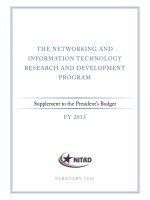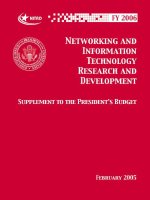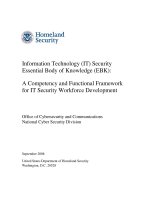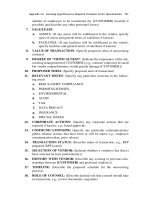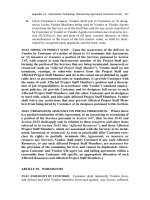optimizing and accessing information technology
Bạn đang xem bản rút gọn của tài liệu. Xem và tải ngay bản đầy đủ của tài liệu tại đây (16.91 MB, 253 trang )
www.it-ebooks.info
P1: TIX/XYZ P2: ABC
JWBT520-fm JWBT520-Proctor June 16, 2011 19:10 Printer: Yet to Come
www.it-ebooks.info
P1: TIX/XYZ P2: ABC
JWBT520-fm JWBT520-Proctor June 16, 2011 19:10 Printer: Yet to Come
Optimizing and
Assessing Information
Technology
i
www.it-ebooks.info
P1: TIX/XYZ P2: ABC
JWBT520-fm JWBT520-Proctor June 16, 2011 19:10 Printer: Yet to Come
Founded in 1807, John Wiley & Sons is the oldest independent publish-
ing company in the United States. With offices in North America, Europe,
Australia, and Asia, Wiley is globally committed to developing and market-
ing print and electronic products and services for our customers’ professional
and personal knowledge and understanding.
The Wiley Finance series contains books written specifically for finance
and investment professionals as well as sophisticated individual investors
and their financial advisors. Book topics range from portfolio management
to e-commerce, risk management, financial engineering, valuation, and fi-
nancial instrument analysis, as well as much more.
For a list of available titles, please visit our web site at www
.WileyFinance.com.
ii
www.it-ebooks.info
P1: TIX/XYZ P2: ABC
JWBT520-fm JWBT520-Proctor June 16, 2011 19:10 Printer: Yet to Come
Optimizing and
Assessing Information
Technology
Improving Business
Project Execution
K. SCOTT PROCTOR, CFA
John Wiley & Sons, Inc.
iii
www.it-ebooks.info
V413HAV
P1: TIX/XYZ P2: ABC
JWBT520-fm JWBT520-Proctor June 16, 2011 19:10 Printer: Yet to Come
Copyright
c
2011 by K. Scott Proctor. All rights reserved.
Published by John Wiley & Sons, Inc., Hoboken, New Jersey.
Published simultaneously in Canada.
No part of this publication may be reproduced, stored in a retrieval system, or transmitted in
any form or by any means, electronic, mechanical, photocopying, recording, scanning, or
otherwise, except as permitted under Section 107 or 108 of the 1976 United States Copyright
Act, without either the prior written permission of the Publisher, or authorization through
payment of the appropriate per-copy fee to the Copyright Clearance Center, Inc., 222
Rosewood Drive, Danvers, MA 01923, (978) 750-8400, fax (978) 646-8600, or on the Web
at www.copyright.com. Requests to the Publisher for permission should be addressed to the
Permissions Department, John Wiley & Sons, Inc., 111 River Street, Hoboken, NJ 07030,
(201) 748-6011, fax (201) 748-6008, or online at www.wiley.com/go/permissions.
Limit of Liability/Disclaimer of Warranty: While the publisher and author have used their
best efforts in preparing this book, they make no representations or warranties with respect to
the accuracy or completeness of the contents of this book and specifically disclaim any implied
warranties of merchantability or fitness for a particular purpose. No warranty may be created
or extended by sales representatives or written sales materials. The advice and strategies
contained herein may not be suitable for your situation. You should consult with a
professional where appropriate. Neither the publisher nor author shall be liable for any loss of
profit or any other commercial damages, including but not limited to special, incidental,
consequential, or other damages.
Microsoft, Microsoft Excel, and Windows are registered trademarks of Microsoft
Corporation.
For general information on our other products and services or for technical support, please
contact our Customer Care Department within the United States at (800) 762-2974, outside
the United States at (317) 572-3993 or fax (317) 572-4002.
Wiley also publishes its books in a variety of electronic formats. Some content that appears in
print may not be available in electronic books. For more information about Wiley products,
visit our web site at www.wiley.com.
Library of Congress Cataloging-in-Publication Data:
Proctor, K. Scott.
Optimizing and assessing information technology : improving business project
execution / K. Scott Proctor.
p. cm. – (Wiley finance Series)
Includes index.
ISBN 978-1-118-00001-4 (hardback); 978-1-118-10261-9 (ebk);
978-1-118-10262-6 (ebk); 978-1-118-10263-3 (ebk)
1. Information technology–Management. 2. Project management. I. Title.
HD30.2.P75615 2011
658.4
038–dc22 2011011000
Printed in the United States of America
10987654321
iv
www.it-ebooks.info
P1: TIX/XYZ P2: ABC
JWBT520-fm JWBT520-Proctor June 16, 2011 19:10 Printer: Yet to Come
DISCLAIMER
Every effort has been made to make this book as complete and accurate as
possible. No warranty, however, is implied. The information provided is on
as “as is” basis. The author and the publisher shall have neither liability nor
responsibility to any person or entity with respect to any loss or damages
arising from the information contained in this book. The names of individ-
uals, companies, and products used in this book are fictitious and are not
based on real entities. No association with any real company, organization,
product, person, place, or event is intended or should be inferred.
v
www.it-ebooks.info
P1: TIX/XYZ P2: ABC
JWBT520-fm JWBT520-Proctor June 16, 2011 19:10 Printer: Yet to Come
vi
www.it-ebooks.info
P1: TIX/XYZ P2: ABC
JWBT520-fm JWBT520-Proctor June 16, 2011 19:10 Printer: Yet to Come
For Kimmell, Page, Harris, and Jazz
vii
www.it-ebooks.info
P1: TIX/XYZ P2: ABC
JWBT520-fm JWBT520-Proctor June 16, 2011 19:10 Printer: Yet to Come
viii
www.it-ebooks.info
P1: TIX/XYZ P2: ABC
JWBT520-fm JWBT520-Proctor June 16, 2011 19:10 Printer: Yet to Come
Contents
Preface xiii
PART ONE
Introduction to the IT Pillars Model
CHAPTER 1
IT Fundamentals 3
Optimizing and Assessing IT 4
Introducing the IT Pillars Model 5
Summary 12
CHAPTER 2
The Role of IT in Business Operations 13
Models and Definitions 13
Strategy 16
Business Model 17
Operating Model 17
Enterprise Architecture 17
CHAPTER 3
The Strategy Pillar 21
From Strategy to Delivery 21
People 23
Process 23
Technology 28
Next Steps 31
CHAPTER 4
The Project Management Pillar 33
From Strategy to Delivery 33
People 37
Process 39
ix
www.it-ebooks.info
P1: TIX/XYZ P2: ABC
JWBT520-fm JWBT520-Proctor June 16, 2011 19:10 Printer: Yet to Come
x CONTENTS
Technology 39
Next Steps 42
CHAPTER 5
The Operational Excellence Pillar 43
From Strategy to Delivery 43
People 47
Process 48
Technology 49
Ending with the Customers 51
CHAPTER 6
The IPM Scorecard 55
Overview of the Process 55
Example Scorecard 57
Template Details 64
Summary 64
PART TWO
Case Study 1: A Mature Organization
CHAPTER 7
Introduction to Case Study 1 67
Company Background 67
Financials 69
Operations 69
IT Organization 69
Corporate and IT Goals 70
CHAPTER 8
The Strategy Pillar of a Mature Organization 73
Background 73
People 73
Process 79
Technology 83
CHAPTER 9
The Project Management Pillar of a Mature Organization 91
People 91
Process 98
Technology 99
www.it-ebooks.info
P1: TIX/XYZ P2: ABC
JWBT520-fm JWBT520-Proctor June 16, 2011 19:10 Printer: Yet to Come
Contents
xi
CHAPTER 10
The Operational Excellence Pillar of a Mature Organization 107
People 107
Process 111
Technology 115
CHAPTER 11
The IPM Scorecard of a Mature Organization 123
Assessed 123
Optimized 126
Summary 131
PART THREE
Case Study 2: A Growing Organization
CHAPTER 12
Introduction to Case Study 2 135
Company Background 135
Financials 137
Operations 137
IT Organization 137
Corporate and IT Goals 139
CHAPTER 13
The Strategy Pillar of a Growing Organization 141
People 143
Process 147
Technology 151
CHAPTER 14
The Project Management Pillar of a Growing Organization 159
People 159
Process 165
Technology 165
CHAPTER 15
The Operational Excellence Pillar of a Growing Organization 175
People 175
Process 182
Technology 186
www.it-ebooks.info
P1: TIX/XYZ P2: ABC
JWBT520-fm JWBT520-Proctor June 16, 2011 19:10 Printer: Yet to Come
xii CONTENTS
CHAPTER 16
The IPM Scorecard of a Growing Organization 191
Assessed 191
Optimized 194
Summary 199
PART FOUR
Tools and Reporting
CHAPTER 17
IT Measures, Metrics, and Indicators 203
Data, Information, Knowledge, and Wisdom 204
Measures, Metrics, and Indicators 204
Benchmarking 205
ROI 205
CHAPTER 18
Reporting 207
Simple IT Assessment 208
PPT Assessment 208
Cost Assessment 208
Acquisition Integration Assessment 210
Red Flag Report 211
Summary 212
CHAPTER 19
Conclusion 213
About the Web Site 221
Notes 223
About the Author 227
Index 229
www.it-ebooks.info
P1: TIX/XYZ P2: ABC
JWBT520-bpreface JWBT520-Proctor June 29, 2011 8:34 Printer: Yet to Come
Preface
T
his book is a guide—its purpose is to aid you in optimizing and as-
sessing information technology (IT). Optimizing and Assessing Informa-
tion Technology: Improving Business Project Execution is designed to be
both easy to use and immediately useful. Put simply, this book is focused
on improving business project execution through effective IT optimization
and assessment.
I wrote this book based on, among other things, my experience working
across the field of IT at companies both small and large, ranging from start-
up enterprises on one extreme, to General Electric (GE) and AstraZeneca
Pharmaceuticals, at the other extreme.
IT is a field and a discipline with a variety of meanings and interpreta-
tions. The working definition of IT that I will use for this book comes from
the Information Technology Associations of America and is, “the study,
design, development, application, implementation, support or management
of computer-based information systems, particularly software applications
and computer hardware.”
1
This book is focused on both assessing and optimizing IT. According to
the Merriam-Webster dictionary, to optimize something is to make it as “ef-
fective or functional as possible,” and to assess something is to “determine
its importance or value.”
As a guide, this book offers a framework for optimizing and assessing
IT. It does not focus in on specific technologies per se—given the rapid and
increasing pace of technical change across the world today, any such focus is
likely to be out of date as soon as it is published. My focus is on a framework
whose principles are designed to stand the test of time and rapid technical
development.
After reading this book, you will be able to (1) generate an accurate
and reliable assessment of a company’s IT operations and (2) identify areas
on which to focus to optimize IT. Topics such as “against what to assess
operations” and “optimized as compared to what” are addressed over the
course of this book.
In the interest of clarity and simplicity, please note that my coverage of
IT in this book extends beyond “technology” itself. I cover various aspects
xiii
www.it-ebooks.info
P1: TIX/XYZ P2: ABC
JWBT520-bpreface JWBT520-Proctor June 29, 2011 8:34 Printer: Yet to Come
xiv PREFACE
of the People, Process, and Technology components associated with IT as
a whole.
Confusion often arises around the differences between the labels of “in-
formation technology (IT)” and “information systems (IS).” Opinions vary
on how and why the IT and IS labels differ. While it is perhaps an over-
simplification, IT is traditionally thought of as a subset of IS. As a discipline,
IS can encompass a broad range of topics, including how various technolo-
gies combine and interact, and can include disciplines such as sociology or
psychology.
For the purposes of this book, my focus is on optimizing and assessing
how various components of IT, including people, processes, and technology,
support and work with broader business strategies and operations. Some
academic definitions of IT and IS may differ from the ones that I employ
here; my aim in clearly articulating a definition and scope for IT is to focus
on meaningful and impactful topics as opposed to labels and definitions.
NEED FOR THIS BOOK
This book addresses a significant and real problem in a large market. Despite
the massive scale and scope of the IT market—global IT spending stood at
$3.9 trillion in 2009
2
—and ample evidence that few IT projects actually suc-
ceed or turn out well,
3
no other useful, reputable, or easy-to-use guide exists.
As a market, IT consists of spending across the IT services, software,
computer hardware, and telecommunications areas. A research report from
Gartner published in 2008 suggests that IT services spending far outweighs
IT products spending. At the time of publication of the Gartner report, IT
services and telecommunication services accounted for 70 percent of total
IT market spending.
This book is focused on helping anyone optimize and assess IT. IT
projects typically are not executed to plan and often represent a large set of
costs. Doing a better job of optimizing and assessing IT offers the potential
to improve business project execution.
For the sake of context, some recent examples of failed IT projects
include Ford’s abandonment of a purchasing system after deployment in
2004 (costing around $400 million) and Sainsbury’s abandonment of a
supply-chain management system after deployment in 2004 (costing around
$527 million).
IT problems have also led to a number of high-profile failures. The
crash and loss of NASA’s Mars Polar Lander in 1999 has been attributed
to a software bug in a single line of computer code.
4
In 1997, software
www.it-ebooks.info
P1: TIX/XYZ P2: ABC
JWBT520-bpreface JWBT520-Proctor June 29, 2011 8:34 Printer: Yet to Come
Preface
xv
specification and design errors led to the explosion of the $350 million
Arianespace 5 rocket.
In contrast to these failures, there are a number of IT project success sto-
ries that underscore the value of good IT optimization and assessment. One
such example is Enterasys Networks’s implementation of Salesforce CRM
(Customer Relationship Management) Service Cloud. This implementation
increased customer satisfaction for technical support to 95 percent while
driving cost savings of 10 percent.
5
In addition to these underlying drivers, Gartner predicted that “by 2015,
most external assessments of enterprise value and viability will include ex-
plicit analysis of IT assets and capabilities.”
6
Thus, there is a compelling
need for this book and its underlying IPM framework to meet the coming
demand from, among other areas, external assessments of enterprise value
and viability.
TARGET AUDIENCE FOR THIS BOOK
Individuals and teams working across all phases of IT project management
represent the primary market for this book. Included in this market are both
typical project management functions, such as project managers, business
analysts, and the like, as well as functions related to more specific IT assess-
ment areas, such as investment due diligence, mergers and acquisitions due
diligence, and other functions.
Secondary markets for this book include business and finance profes-
sionals with an interest in IT, consultants working in the IT space, and
students interested in IT.
Typical reader profiles for this book might include: a project manager
working on projects with some element of IT; a business analyst responsi-
ble for mapping and/or understanding how certain IT elements relate to an
overall process; a business development professional assessing the IT opera-
tions of a partner or potential partner company; and an investment manager
assessing a company’s IT operations.
SUMMARY OF CONTENTS
Optimizing and assessing IT involves a step-by-step process whereby various
aspects of IT are evaluated. This book is organized into four discrete sec-
tions. In addition to the book itself, a companion web site offers templates,
checklists, and related materials for your reference and use.
www.it-ebooks.info
P1: TIX/XYZ P2: ABC
JWBT520-bpreface JWBT520-Proctor June 29, 2011 8:34 Printer: Yet to Come
xvi PREFACE
Part One of the book introduces the concept of the IT Pillars Model
(IPM) for optimizing and assessing IT. This framework is explained in detail
and compared to other common frameworks currently used in a variety of
ways across IT. The IPM consists of three “pillars”—Strategy, Project Man-
agement, and Operational Excellence—as well as three “components”—
People, Process, and Technology.
Part One provides a solid foundation for the reader in terms of where
and how the IPM fits into the overall operations of a business. Concepts
ranging from strategic direction to enterprise architecture are contextualized
and covered.
The topic of how a business’s strategic direction relates to its IT opera-
tions is covered in Part One as well. The relationship between a company’s
strategic direction and how it manages and utilizes IT is a critical area for
consideration and analysis.
Finally, Part One covers the process involved in quantifying the IPM.
Each area of the IPM is assessed and the manner in which these assessments
can be quantified and summarized is described in detail.
Parts Two and Three of the book examine each aspect of the IPM in the
context of case studies. Using fictitious (but realistic) company information,
each of the components of the framework (People, Process, and Technol-
ogy) is evaluated across each of the framework’s pillars (Strategy, Project
Management, and Operational Excellence).
Part Two covers the IPM as it relates to a large and mature organization.
Part Three covers the IPM as it relates to a midsize and growing organization.
In essence, Parts Two and Three of the book offer a detailed, hands-on
user’s guide to the principles and practice of the IPM. Part One offers up
some important ideas and principles for strategy and IT, while Parts Two
and Three present step-by-step guidance for how a company’s IT operations
should be assessed and optimized.
The final section of the book, Part Four, covers tools and reporting.
Analytical tools such as ROI (return on investment), benchmarking, and
metrics are covered in this section. In addition, Part Four discusses a series
of useful reports for IT optimization and assessment.
Finally, a companion web site is available for this book at
www.wiley.com/go/proctorit. This web site complements the book and of-
fers a variety of materials, including templates, checklists, and figures, that
are referenced throughout the book itself.
www.it-ebooks.info
P1: TIX/XYZ P2: ABC
JWBT520-bpreface JWBT520-Proctor June 29, 2011 8:34 Printer: Yet to Come
Optimizing and
Assessing Information
Technology
xvii
www.it-ebooks.info
P1: TIX/XYZ P2: ABC
JWBT520-bpreface JWBT520-Proctor June 29, 2011 8:34 Printer: Yet to Come
xviii
www.it-ebooks.info
P1: TIX/b P2: c/d QC: e/f T1: g
JWBT520-c01 JWBT520-Proctor June 25, 2011 12:37 Printer: Yet to Come
PART
One
Introduction to the
IT Pillars Model
1
www.it-ebooks.info
P1: TIX/b P2: c/d QC: e/f T1: g
JWBT520-c01 JWBT520-Proctor June 25, 2011 12:37 Printer: Yet to Come
2
www.it-ebooks.info
P1: TIX/b P2: c/d QC: e/f T1: g
JWBT520-c01 JWBT520-Proctor June 25, 2011 12:37 Printer: Yet to Come
CHAPTER
1
IT Fundamentals
I
nformation technology (IT) is a label that is used in many ways in today’s
increasingly technically focused world. Such wide and varied usage of the
“information technology” or “IT” label can lead to confusion and unneces-
sary complexity. For that reason, I begin this book with an explanation of
the context in which I am addressing IT.
IT is more than a function within a business and more than a technical
discipline. As noted in the Preface, IT may be characterized as “the study,
design, development, application, implementation, support or management
of computer-based information systems, particularly software applications
and computer hardware.”
1
Parsing even further into the formal definition of IT, the Merriam-
Webster dictionary defines “information” as “knowledge obtained from
investigation, study, or instruction,” and “technology” as “the practical ap-
plication of knowledge, especially in a particular field.” Information may
also be characterized as data, or “raw symbols,” that have been given mean-
ing by relational connections.
2
Reading into the formal definitions of IT, one interpretation is “the
practical application of information in commerce and industry.” This is the
definition that I will use throughout this book for IT.
This is but one way of contextualizing IT—while the term can take a
variety of meanings, it is important to ground any IT-related conversations
in a common definition and understanding of IT itself.
Beyond any formal definition, however, IT may be characterized as
having three “components”: People, Process, and Technology. Put another
way, the practical application of information in commerce involves three
components: (1) People, or the individuals and teams involved in work;
(2) Process, or the manner in which certain tasks and activities are ac-
complished; and (3) Technology, or the systems and tools utilized to
accomplish work.
3
www.it-ebooks.info
P1: TIX/b P2: c/d QC: e/f T1: g
JWBT520-c01 JWBT520-Proctor June 25, 2011 12:37 Printer: Yet to Come
4 INTRODUCTION TO THE IT PILLARS MODEL
While the purpose or role of IT may vary across industries, companies,
and geographies, a lowest common denominator may be that of IT serving
as an “enabler,” or a vehicle for facilitating action. There may well be excep-
tions to this characterization, but IT regularly serves as an aid or a tool that
facilitates an activity, such as, for example, processing order transactions
quickly or processing large volumes of data efficiently and accurately.
As noted in the Preface, confusion can arise related to the differences
between the labels of information technology (IT) and information systems
(IS). My focus in this book is on IT—specifically on optimizing and assessing
how various components of IT support and function with broader business
strategies and operations.
IT represents a large market—global spending reached $3.9 trillion in
2009.
3
Despite the size of the global market, a large number of project
examples indicate that few IT projects actually succeed or turn out well.
4
These dynamics—a large market with poor delivery results—underscore the
need for this book and the IT Pillars Model (IPM).
OPTIMIZING AND ASSESSING IT
As noted in the Preface, the Merriam-Webster dictionary defines “optimize”
as making something as “effective or functional as possible,” and “assess” as
to “determine its importance or value.” This book is focused on optimizing
and assessing IT.
In order to generate an IT assessment and an idea of what “optimized”
might look like, a goal, or desired end state, for how IT should work across
an organization is needed. In other words, we need to define our target in
order to properly assess and optimize IT.
While the goal of IT may vary across companies, one common theme
heard from chief information officers across a large number of surveys
sponsored by the Center for Information Systems Research (CISR) of the
Massachusetts Institute of Technology (MIT) is that their most important
concern is “alignment with business strategy.”
5
Part of the IPM entails eval-
uating how well the goals of an IT organization align with the rest of a
business’s operations.
An overarching goal of the IPM, and of this book, is to seek simplicity.IT
can be a complex field and topic—a focus of mine is to distill the important,
or “vital,” aspects of IT out of the otherwise often complex IT landscape.
To paraphrase Oliver Wendell Holmes, there is power in “simplicity on the
other side of complexity.”
www.it-ebooks.info
P1: TIX/b P2: c/d QC: e/f T1: g
JWBT520-c01 JWBT520-Proctor June 25, 2011 12:37 Printer: Yet to Come
IT Fundamentals
5
At a high level, the processes of optimizing and assessing IT involve a
small number of important steps. These eight steps include:
1. Define the goal. Define the desired end state of the IT function.
2. Assess the situation. Assess the current IT function against the desired
end state.
3. Quantify the situation. Translate the assessment of the current IT func-
tion into quantitative terms.
4. Identify the gaps. Determine where gaps exist between the desired IT
end state and the current situation utilizing the quantified IT assessment
5. Determine a plan to bridge the gaps. Build a plan to bridge the gaps
between the current situation andthedesired end state of the IT function.
6. Quantify the benefits of bridging the gaps. Translate the plan to bridge
the gaps into quantitative terms.
7. Execute the plan to bridge the gaps. Move forward and implement the
plan to fill the gaps
8. Repeat these steps. Reassess the IT function in the future and begin the
optimization process again
Figure 1.1 illustrates the steps involved in optimizing and assessing IT.
INTRODUCING THE IT PILLARS MODEL
The IPM is a framework for easily assessing and optimizing IT. The focus
is on simplicity and driving value. As a variety of models and frameworks
have been used across the field of IT, I focus here on the specifics underlying
the IPM. I cover what is in scope and, in Chapter 2, how this model relates
to a number of other IT models and frameworks.
Put simply, the IPM evaluates the components of people, process, and
technology against three “pillars,” or areas of focus for IT. By evaluating a
company’s IT operations using the IPM, it is possible to both assess the IT
function and identify areas for possible optimization.
The IPM gets its name from three IT pillars. These pillars are (1) Strategy,
(2) Project Management, and (3) Operational Excellence. In this context, a
pillar refers to a fundamental principle or foundational idea. These three
pillars, taken together, cover the typical areas of interest and focus for IT.
Figure 1.2 presents a summary view of the IPM.
For easy reference, each of the cells in the matrix is numbered. I cover the
meaning and relevance of each of the cells and refer back to the numbered
cells on a regular basis over the course of this book.
www.it-ebooks.info
